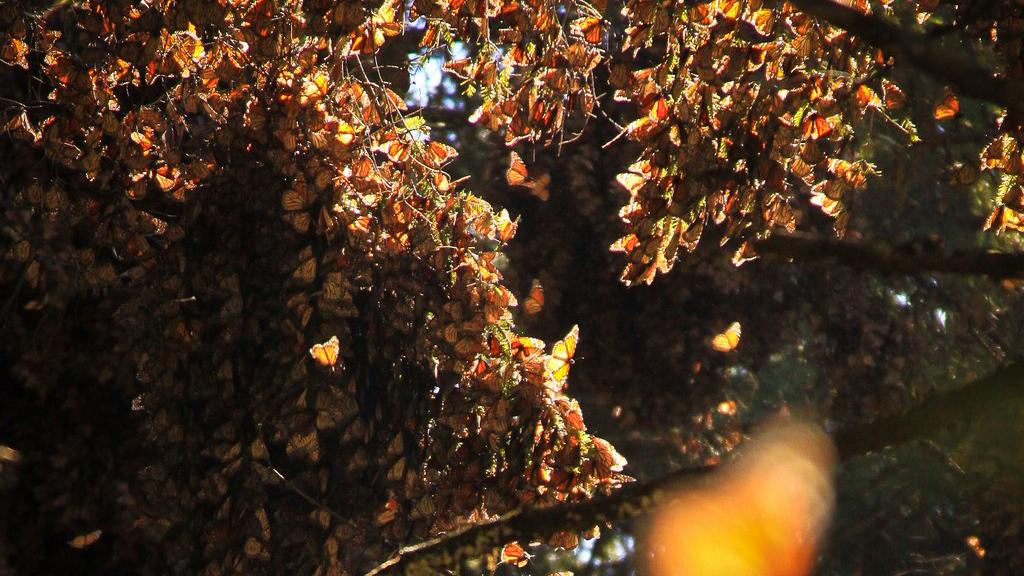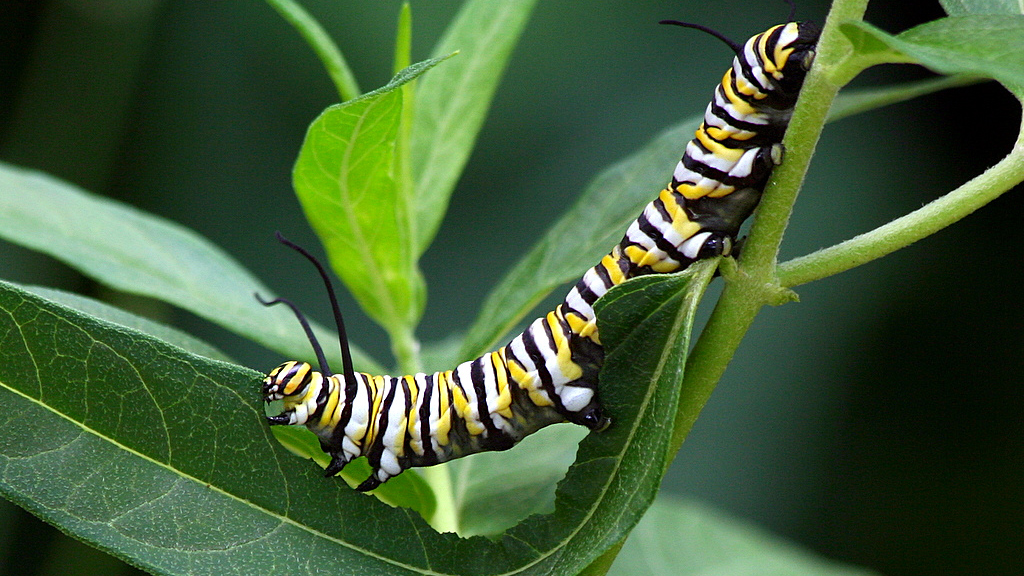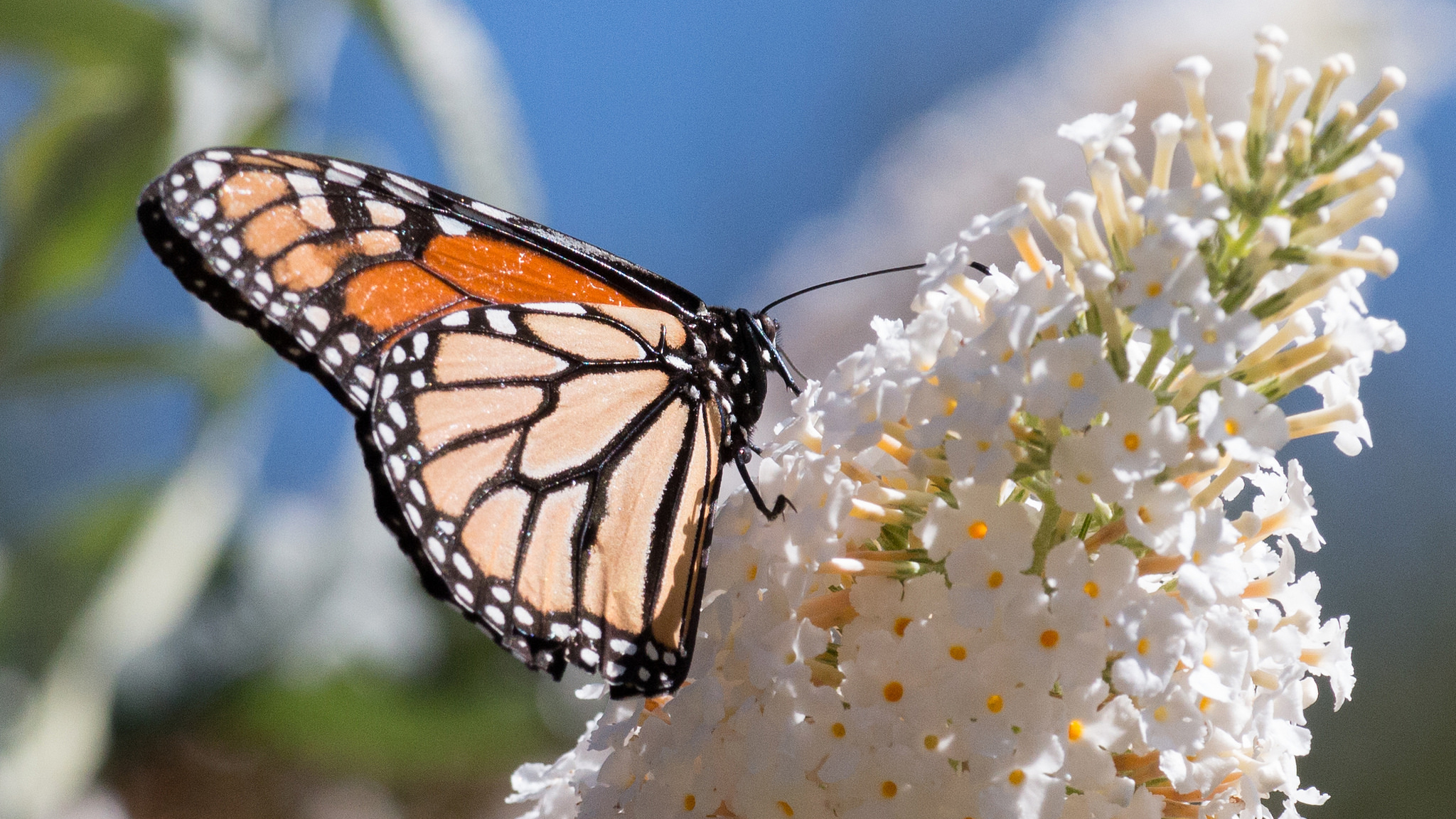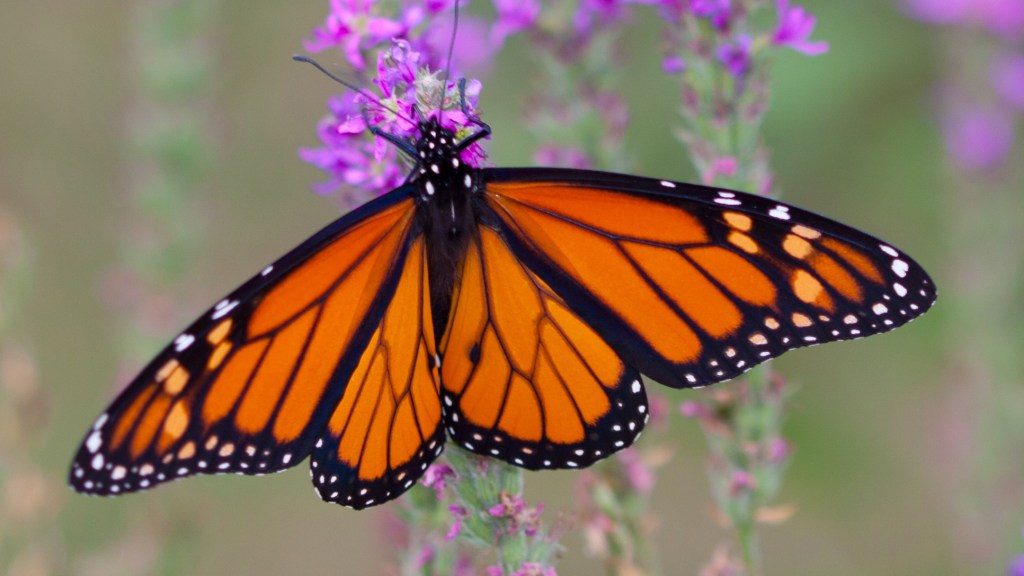Twenty years ago, monarch butterflies occupied so much area in Mexico during the winter you could see it from space. It totaled about 20 hectares, or almost 50 acres, with millions if not billions of butterflies clinging to trunks and branches of trees.
Today, that area is around 4 hectares. The previous year had 1.1 hectares, says Brice Semmens, Assistant Professor at the Scripps Institution of Oceanography at the University of California San Diego.
Semmens was the lead author on “Quasi-extinction risk and population targets for the Eastern, migratory population of monarch butterflies” published recently in the journal Scientific Reports. It is one paper in a long line of sobering butterfly news.
The monarch likely won’t ever become extinct, Semmens says. Small populations live scattered throughout Mexico, the central U.S. and Canada, and some were moved to places as far away as Hawaii and New Zealand.
But the massive eastern migrations between central Mexico and Canada that have inspired people for centuries could be lost.
Semmens’ paper used expert opinion to determine how little occupied winter habitat in Mexico would be needed to sustain a viable migratory population – and at what point it simply may not bounce back.

The authors used estimates of extinction rates with various overwintering sizes, and conclude monarchs need about 6 hectares, or about 15 acres, to cut the risk in half.
But in order to understand how to boost overwintering numbers, people must first understand what hazards the eastern monarch faces.
Semmens and University of Minnesota monarch expert Karen Oberhauser recently walked the Cool Green Science Blog through each threat, as well as some possible solutions.
Habitat Loss
This one isn’t a surprise. Many North American species face some kind of habitat loss, but the eastern monarch is struggling throughout its three-country migration route.
In the winter, the butterflies need insulated cover in the form of dense Mexican forests. While the area is protected by the Mexican government, its edges are still being eaten away by illegal logging.
But also critical are the other migratory stages. In each one between Mexico, the Midwestern U.S. and southern Canada, monarchs need milkweed. They can only reproduce with the flowering plant.

And since each annual migration might create four or even five generations of monarchs, less milkweed directly correlates to fewer butterflies, according to Oberhauser. Unfortunately, the plant has been effectively removed by the millions from most agricultural fields and neighboring areas throughout the Midwest.
“The hopeful thing is that monarchs can really use habitat in a lot of different places,” she says. “It’s not like we’re talking about spotted owls that need hundreds of acres of untouched forest. They can find a milkweed plant growing in a crack in a sidewalk.”
Climate Change
Monarchs suffer under drought and severe storms, two weather events becoming more common with climate change.
“If you imagine an EKG or something, a line going up and down, insect populations in general are very erratic,” says Oberhauser. “They are very driven by weather conditions and what we call stochastic variation, variation we don’t have control over and can’t predict.”
The biggest risk with storms is freezing to death. Butterflies can survive temperatures down to about 17 degrees Fahrenheit if the cold is dry. But temperatures of about 25F with rain often mean death. A single storm in 2002, for example, killed almost 80 percent of the monarch population.
“That year the population was pretty high,” Oberhauser says. “But two years ago when the population was down to under 1 hectare, if we lost 80 percent, the number might have been too small to be a viable population.”
Pesticides and Herbicides
Milkweed used to grow scattered throughout corn and soybean crops across the Midwest. But more efficient agriculture practices and products such as Roundup have nearly eliminated monarch habitat, according to Semmens.
“It’s not that the use changed, it’s still agriculture, but the weed control changed and made it hard for monarchs,” he says.

Monarchs are also suffering from something called neonicotinoids, a relatively new class of insecticides with poison growing in all tissues of the plant. They make the plant itself poisonous to insects.
So what can you do?
Leaders of all three North American countries have decided monarchs are a priority. As a result, the U.S. government, through the departments of the Interior and Agriculture, are creating strategic goals for increasing habitat.
The U.S. needs about 1.5 billion new stems of milkweed, or about 500 million new plants, to help reach the 6 hectare overwintering goal, says Wayne Thogmartin, a research ecologist with the USGS.
“It will require participation from all sectors of society,” he says. “If we try and rely on any single sector we won’t reach our goals. If we say this is an agricultural problem and we need to rely on them to solve it, it won’t get solved. If we say we will achieve this by having everyone plant milkweed in their backyard, it won’t solve the problem. We need everyone’s participation.”
But each person can make a difference.
Here are a few places the researchers suggest to start:
- Create habitat in your backyard, school or office. If you can, remove some grass and put in a garden. Each new plant makes a difference.
- Sign up for monarch citizen science projects and collect data for researchers. For more information, go to monarchjointventure.org.
- Ask before you buy. If you want to plant a pollinator-friendly garden, ask to be sure the seeds or plants weren’t treated with neonicotinoids.
- Talk to your friends, neighbors and relatives.
- Donate to organizations working for conservation of habitat including The Nature Conservancy, the Monarch Joint Venture and the Monarch Butterfly Fund.




My wife and I have owned about one acre of semi-open landin southern New Hampshire for about 12 years. We have some milkweed and until a few years there were always some Monarchs at every stage of development. The milkweed is still there but we have had no Monarchs for the last few years. Not a habitat loss problem. What might have happened? Whit might be done?
I heard that the Mexican butterfly refuge was hit by a heavy, wet snowstorm this Spring. If so, the migrating population of monarch butterflies could well be decimated by now, but monarchs by themselves are not going to be wiped out, as there is still a sizeable population in S. Florida, among other places, to enable the species to recover. The lack of milkweed up north could hinder that re-population, however.
Hi Christine, thank you for using your platform to bring attention to these hazards threatening the monarch population, and also sharing a few ways that people can make a difference.
While creating a garden habitat is helpful, when combined with raising a few monarchs indoors, it can boost their survival rate from less than 5% to over 90%, and that truly makes a difference even when raising just a few!
Here are 21 Tips for Raising Healthy Monarchs Indoors:
http://monarchbutterflygarden.net/how-to-raise-monarch-butterflies-inside/
My milkweed gets eaten down to the nubs by rodents. I have to put them in pots(they don’t thrive like they do in the ground). I found out that it does not poison them but instead makes them”high”. Any ideas on how to deal with this problem?
Every creature deserves a place on this globe that isn’t ours only but everyone’s. We all need to be altruists in order to save what’s left of our planet and leave it to nature.
Saying that “Every creature deserves a place on this globe that isn’t ours only but everyone’s” is the ultimate sentiment. Although not realistic when u have a single species of 7-8 billion projected to reach 10 billion by 2050.
My daughter amd I visited one of the Monarch preserves in Mexico several years. There are no words to describe entering a world of butterflies. Just that it is a life changing experience. Please help preserve and protect this magnificent species. Anyone can plant milkweed anywhere!
I absolutely agree that we need to support conservation organizations in their efforts to protect the Monarch and also pollinators which are in decline. If you plant milkweed, Monarchs will come! Our major priority should be to create habitat by planting native (please source these from your geographic region) milkweed and nectar sources. Milkweed seeds or plants from Minnesota should not be planted in Texas, even if they are a native species. These organizations will help you find natives for your geographic region. Monarch Watch’s Milkweed Market (http://monarchwatch.org/milkweed/market/) and Xerces Society Milkweed Project (http://www.xerces.org/milkweed/) to find sources for native milkweed for your state or ecoregion. Nectar sources are critical for the Monarch butterfly migration. If you’d like to learn how to create habitat, attract, and rear your local wild butterflies, moths, and pollinators, hobbyists are welcome to join our Facebook conservation group. Rearing is optional, learning how to create habitat is critical for their survival. Also, learning how to rear healthy Monarchs is critical. We don’t want to further weaken the wild population by introducing diseases. Raising Butterflies and Moths for Conservation (+ All Pollinators) on Facebook: https://www.facebook.com/groups/butterflyandmothconservation/
I recently purchased two “Silky Gold” Blood Flower Asclepias curassavica plants for my garden in Myrtle Beach, SC. (Coastal South) When I googled this milkweed plant to learn about care I was alarmed by an article I read suggesting that this tropical milkweed is detrimental to the Monarch Butterfly. The article from Monarchbutterflygarden. net said that this tropical plant has a longer growing period then the native milkweed and that the Monarch’s stay in the geographic area longer than they should, into the cooler months and miss their migration and die. It also said that there is a build up of OE spores on the old growth of this plant and that the Monarch’s become infected and die. It stated that research on this plants impact on the Monarch’s are ongoing. But, that to prevent some of the detrimental effect of the plant it should be cut down to the ground at least twice during it’s growth period to reduce possibility of harm to the Monarch population. After learning about this, I called the Nursery where I purchased the plant and informed them of the about issues. I had already planted the Blood Flower and will now make sure to cut it back at least twice during the season. But, I fear that those purchasing the plant may not be aware of its possible harmfulness to the Monarch Butterfly.
The North American Butterfly Association, Jeffrey Glassberg, published an article on tropical milkweed (Asclepias curassavica). http://nababutterfly.com/wordpress/wp-content/uploads/2015/04/Tropical-Milkweed.pdf Please read it for a better understanding of the issues with planting tropical milkweed. Planting natives is always best, but what if native milkweeds are not available.
OE spores build up on all milkweeds by the fall. The northern states can be clean in the spring due to every milkweed dying back, but by the fall there is a buildup of OE spores on all milkweed plants due to
Monarchs with OE visiting plants (wash plants before feeding to caterpillars). Tropical milkweed (Asclepias curassavica) is native to Mexico and possibly the gulf of Texas. Monarchs traveling north and south lay eggs on tropical milkweed as they go through Mexico.
If we rear Monarchs, it is critical to make sure we start out with clean/sanitized rearing containers in the spring. OE spores can lie dormant inside for over a year and even one spore can infect a caterpillar. Learn more about OE and rearing healthy Monarchs at Project Monarch Health:
http://www.monarchparasites.org/ It is also a good idea not to buy butterflies in any stage. Farmed butterflies can carry diseases and we don’t want to make our wild populations sick. Some diseases can infect all butterfly and moth species. Be patient, wait for them to come naturally.
YOU CAN COUNT WHITH ME, I LIVE AT JILOTEPEC MÉXICO, I HAVE A BIG GARDEN. EACH YEAR THE MONARCH BUTTERFLY FLY OVER THIS BEATEFULL PLACE, I HAVE SEEN THEM, I WILL PLANT A BEATEFULL GARDEN FOR THEM.
I have been told warned that is important to use locally native milkweed to help the Monarch. Apparently other milkweed can have a different growth habit that does not fit the migration pattern. I have seen how this may be so with tropical milkweed that kept the new butterfly here instead of heading north. Is there any solid research backing this up or was I just being shown an anomaly?
Hi Karl, Thank you! Yes, this fact sheet from the Monarch Joint Venture goes into some of the risks from planting non-native milkweed (http://monarchjointventure.org/images/uploads/documents/Oe_fact_sheet.pdf) and you can find out how to get milkweed that is native to your region from the Xerces Society (http://www.xerces.org/milkweed/).
Thank you for this article. It is sobering but I believe we can Bring Back the Monarchs. We care. We plant. We talk and share. And we plant some more. It is wonderful to go out into the garden in mid summer and see Monarchs, other butterflies, bees and other insects and bird dancing through our Monarch Waystation. I have been inspired by the actions and commitment of so many people. I’m in 200%! For those living in northern Virginia, Loudoun Wildlife Conservancy is working with Monarch Watch and we will have a series of milkweed plant sales from Mid-May through Mid-June: 7,000 pesticide-free native milkweed plants, $3 each. Every one makes a difference.
Article is wrong to state or imply that planting milkweed would boost monarch numbers. Why? Because currently roughly 4 billion milkweed plants in eastern North America support a population of 200 million fall migrant monarchs. In other words, roughly 20 plants = 1 fall migrant monarch. So to increase the fall migrant monarch population just one percent, 40 million new milkweed plants would have to be planted and successfully established in wildscape situations (e.g. roadsides). Is that logistically possible? Absolutely not! If it were possible then this article and others like it would post photos of milkweed patches that were successfully established in wildscape situations and post the procedures that were followed to attain that success. But none do nor will they ever because the amount of time and labor involved to establish just a handful of new patches is tremendous.
You think that the amount of plants is not the issue? What could we do besides planting milkweed? I had a patch of over 120 plants this summer, and all generations of Monarchs did well except the migratory generation. Lots of insects showed up from nowhere and decimated my migratory generation! Any suggestions? Alice Chase
Thanks Christine! Great article. If anyone needs milkweed, Monarch Watch is looking for schools to plant it and they will send you plugs for free: https://docs.google.com/forms/d/1gRdsZBcqXFoT8ye9LxuMIKoRdJ0J7kbV7WPx7dBJim0/viewform?c=0&w=1
I have common milkweed seeds & seedlings for free as well, and will be distributing them throughout Vermont and New England, http://vermontfurnitureblog.com/conserving-monarch-habitat.
HI I live in central Ontario (Canada ) we have just over an acre outside of the town line. I would love to help by planting this as much as I can on our land but I don’t know if it will help them up here or anything about growing Milk weed inclung where to get the seeds up here. I also would like to ask a question even at the risk of sounding uneducated. But here it goes….
I notice caterpillars in the yard right when the weather is turning cold in the fall. It can and does get really cold really quick up here. I wanted to know if that kind of weather change will kill the caterpillars and if so can I set up a habitat in the house just until the weather warms up in the spring or is that just a silly idea.. please let me know what you think.. thank you Kris.
Adult Monarchs can withstand temperatures down below 25F, if they are not wet. The caterpillars and chrysalises are not as cold tolerant. Temperatures below 40 may kill them, but it depends on where the milkweed plants are located. Plants near buildings and rocks can provide a micro climate. It will be warmer there.
There is a Facebook group for Ontario focusing on Monarchs: Monarchs Migrating Through Ontario: https://www.facebook.com/groups/711833448865330/
Maybe someone on that list can give you some native Canadian milkweed seeds. I think it is important for us to plant seeds that are native to our region. Also, I posted a PDF (How to Raise Monarch Butterflies) in their files. You just need to join and click on the files to download. That PDF will take you though the cycle from hatching eggs to releasing the adults.
If you’d like to learn more, plus keep up-to-date conservation wise for the Monarch butterflies and other pollinators, please join our North American conservation group for hobbyists on facebook:
https://www.facebook.com/groups/butterflyandmothconservation/
Thank you Mona! To add to your resources, here is a page from Monarch Butterfly Garden that lists milkweed species native to North America and lists their ranges by state and province: http://monarchbutterflygarden.net/milkweed-plant-seed-resources/
Thorough and informative, Christine. I would like to add that having witnessed Monarchs choosing new milkweed sprouts as their preferred plant to deposit their eggs, I have harvested as many of these tender shoots as possible before I mow my lawn and placed the stems in water. The plants do not root but they live long enough for the eggs to hatch. When I see a caterpillar I place the container near established plants. Thank You, Richard